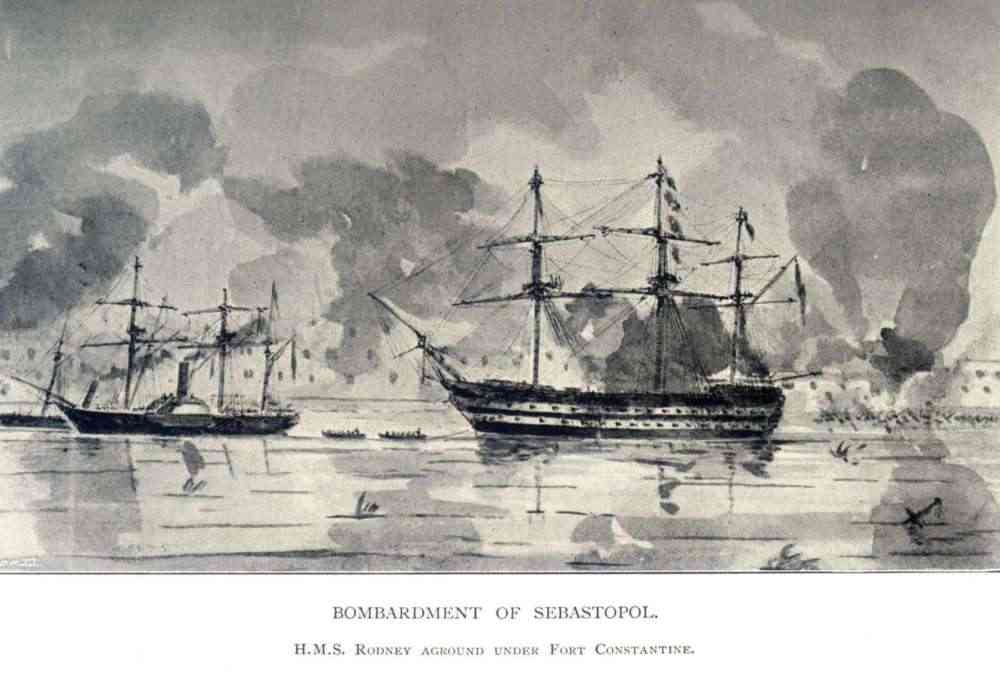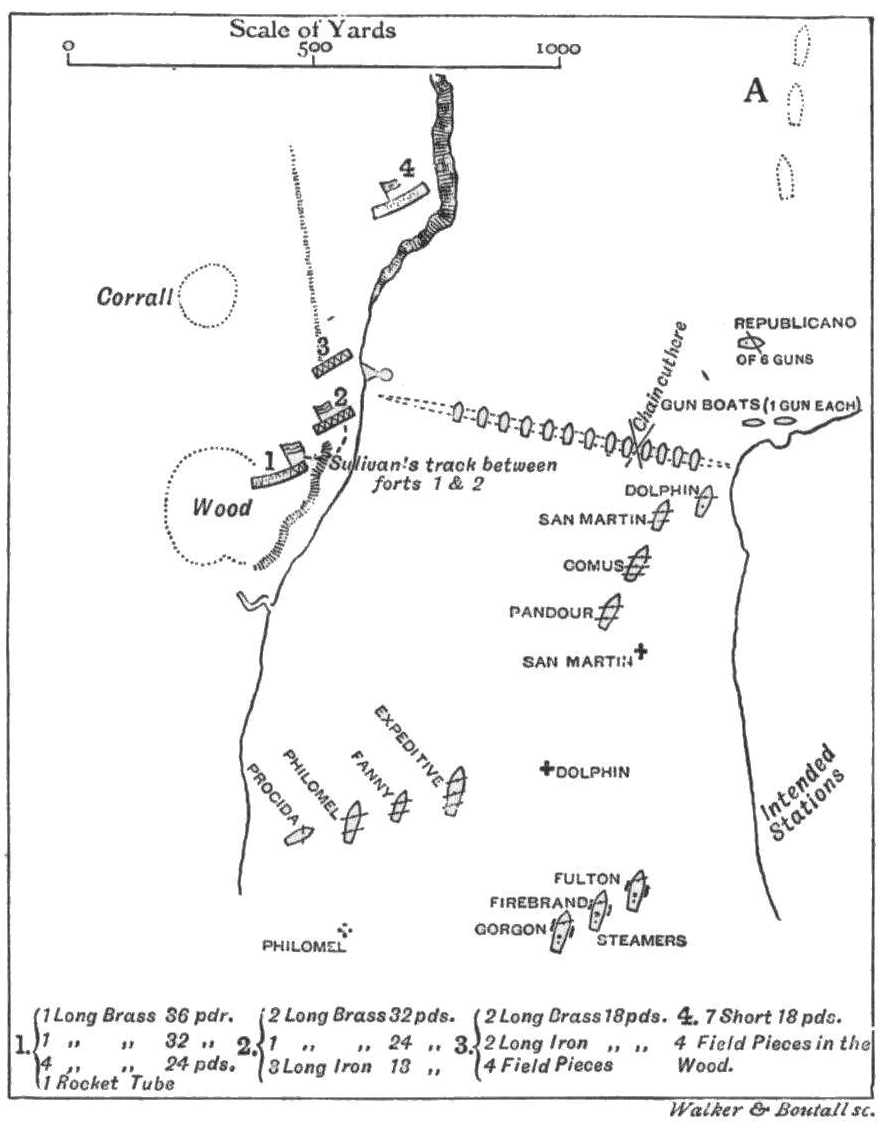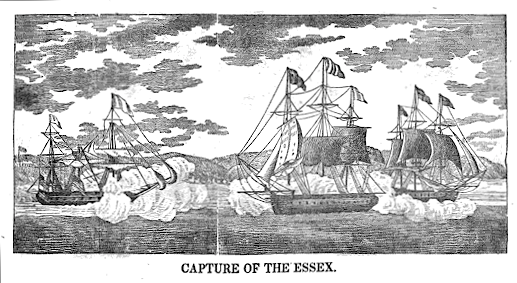|
John Edmund Commerell
Admiral of the Fleet Sir John Edmund Commerell, (13 January 1829 – 21 May 1901) was a Royal Navy officer. As a junior officer, he was present at the Battle of Vuelta de Obligado in November 1845 during the Uruguayan Civil War. He also took part in operations in Sea of Azov during the Crimean War and went ashore with the quartermaster and a seaman, to destroy large quantities of enemy forage on the shore. After a difficult and dangerous journey they reached their objective – a magazine of corn – and managed to ignite the stacks, but the guards were alerted and immediately opened fire and gave chase. The men had difficulty in escaping, but they finally reached their ship and the lookouts later reported that the forage store had burned to the ground. He and his colleague, Quartermaster William Thomas Rickard, were awarded the Victoria Cross, the highest award for gallantry in the face of the enemy that can be awarded to British and Commonwealth forces. Commerell went on to ... [...More Info...] [...Related Items...] OR: [Wikipedia] [Google] [Baidu] |
Grosvenor Square
Grosvenor Square is a large garden square in the Mayfair district of London. It is the centrepiece of the Mayfair property of the Duke of Westminster, and takes its name from the duke's surname "Grosvenor". It was developed for fashionable residences in the 18th century. In the 20th it had an American and Canadian diplomatic presence, and currently is mixed use, commercial. History Sir Richard Grosvenor obtained a licence to develop Grosvenor Square and the surrounding streets in 1710, and development took place between 1725 and 1731. The land was sold in individual plots, with 30 different builders or partnerships taking a lease; about half of these had become bankrupt by 1738. Grosvenor Square was one of the three or four most fashionable residential addresses in London from its construction until the Second World War, with numerous leading members of the aristocracy in residence. The early houses were generally of five or seven bays, with basement, three main stories a ... [...More Info...] [...Related Items...] OR: [Wikipedia] [Google] [Baidu] |
Battle Of Vuelta De Obligado
The naval Battle of Vuelta de Obligado took place on the waters of the Paraná River on 20 November 1845, between the Argentine Confederation, under the leadership of Juan Manuel de Rosas, and a combined Anglo-French fleet. The action was part of the larger Anglo-French blockade of the Río de la Plata. Although the attacking forces broke through the Argentine naval defenses and overran the land defenses, the battle proved that foreign ships could not safely navigate Argentine internal waters against its government's wishes. The battle also changed the political attitude toward the Confederation in South America, increasing support for Rosas and his government. Background During the 1830s and 1840s, the British and French governments were at odds with Juan Manuel de Rosas' leadership of the Argentine Confederation. Rosas' economic policies of requiring trade to pass through the Buenos Aires custom house – which was his method of imposing his will on the Littoral provinces � ... [...More Info...] [...Related Items...] OR: [Wikipedia] [Google] [Baidu] |
Paraná River
The Paraná River ( es, Río Paraná, links=no , pt, Rio Paraná, gn, Ysyry Parana) is a river in south-central South America, running through Brazil, Paraguay, and Argentina for some ."Parana River". Encyclopædia Britannica. Encyclopædia Britannica Online. Encyclopædia Britannica Inc., 2012. Web. 26 May. 2012 . "Rio de la Plata". Encyclopædia Britannica. Encyclopædia Britannica Online. Encyclopædia Britannica Inc., 2012. Web. 26 May. 2012 Among South American rivers, it is second in length only to the Amazon River. It merges with the Paraguay River and then farther downstream with the Uruguay River to form the Río de la Plata and empties into the Atlantic Ocean. The first European to go up the Paraná River was the Venetian explorer Sebastian Cabot, in 1526, while working for Spain. A drought hit the river in 2021, causing a 77-year low. Etymology In eastern South America there is "an immense number of river names containing the element ''para-'' or ''parana-''", f ... [...More Info...] [...Related Items...] OR: [Wikipedia] [Google] [Baidu] |
Pacific Station
The Pacific Station was created in 1837 as one of the geographical military formations into which the Royal Navy divided its worldwide responsibilities. The South America Station was split into the Pacific Station and the South East Coast of America Station. History The British Pacific Squadron was established in 1813 to support British interests along the eastern shores of the Pacific Ocean at Valparaíso, Chile. In 1837, when the South America station was split, this responsibility was passed to the Commander-in-Chief, Pacific. In 1843, Lord George Paulet, George Paulet, captain of , took her out from Valparaíso to Honolulu to demand the islands of the Kingdom of Hawaii for Britain. King Kamehameha III capitulated and signed the islands over to Paulet. In the summer of that year, Rear-Admiral Richard Darton Thomas set out from Valparaíso in to rein Paulet in. On 31 July 1843, Thomas assured the King that the occupation was over and that there was no Paulet Affair (1843) ... [...More Info...] [...Related Items...] OR: [Wikipedia] [Google] [Baidu] |
HMS Firebrand (1842)
Eleven ships of the Royal Navy have borne the name HMS ''Firebrand''. * was an 8-gun fireship launched in 1694 and wrecked in 1707. * was an 8-gun fireship, previously the civilian vessel ''Charming Jenny''. She was purchased in 1739 and sold in 1743. * HMS ''Firebrand'' was a 10-gun fireship, previously a 20-gun sixth rate launched in 1731 as . She was converted to a fireship in 1746 and renamed HMS ''Firebrand'' in 1755. She was reconverted to a sixth rate in 1757 and renamed HMS ''Penguin''. The French captured her in 1760. * HMS ''Firebrand'' was a fireship, previously a 16-gun sloop purchased in 1777 as . She was converted to a fireship, renamed HMS ''Firebrand'' in 1778, and was burnt in 1781. * was a fireship purchased in 1794 and broken up in 1800. * HMS ''Firebrand'' (1804a), was the French privateer brig ''Adèle'', that captured in November 1800 and that became the British East India Company's armed brig ''Waller''. The Royal Navy purchased her at London in August 1 ... [...More Info...] [...Related Items...] OR: [Wikipedia] [Google] [Baidu] |
Frigate
A frigate () is a type of warship. In different eras, the roles and capabilities of ships classified as frigates have varied somewhat. The name frigate in the 17th to early 18th centuries was given to any full-rigged ship built for speed and maneuverability, intended to be used in scouting, escort and patrol roles. The term was applied loosely to ships varying greatly in design. In the second quarter of the 18th century, the 'true frigate' was developed in France. This type of vessel was characterised by possessing only one armed deck, with an unarmed deck below it used for berthing the crew. Late in the 19th century (British and French prototypes were constructed in 1858), armoured frigates were developed as powerful ironclad warships, the term frigate was used because of their single gun deck. Later developments in ironclad ships rendered the frigate designation obsolete and the term fell out of favour. During the Second World War the name 'frigate' was reintroduced to des ... [...More Info...] [...Related Items...] OR: [Wikipedia] [Google] [Baidu] |
HMS Cornwallis (1813)
HMS ''Cornwallis'' was a 74-gun third rate ship of the line of the Royal Navy, launched on 12 May 1813 at Bombay. She was built of teak. The capture of ''Java'' by delayed the completion of ''Cornwallis'' as ''Java'' had been bringing her copper sheathing from England. ''Cornwallis'' arrived at Deal, Kent on 31 May 1814, having escorted several East Indiamen (including , , and ), and two whalers (including ). On 27 April 1815, ''Cornwallis'' engaged the American sloop , which had mistaken ''Cornwallis'' for a merchant ship. Heavily outgunned, ''Hornet'' was forced to retreat. The crew threw boats, guns and other equipment overboard in order to escape.James (1837), Vol.6, p.387. After China's defeat in the First Opium War, representatives from the British and Qing Empires negotiated a peace treaty aboard ''Cornwallis'' in Nanjing. On 29 August 1842, British representative Sir Henry Pottinger and Qing representatives, Qiying, Yilibu and Niujian, signed the Treaty of Nanki ... [...More Info...] [...Related Items...] OR: [Wikipedia] [Google] [Baidu] |
Third-rate
In the rating system of the Royal Navy, a third rate was a ship of the line which from the 1720s mounted between 64 and 80 guns, typically built with two gun decks (thus the related term two-decker). Years of experience proved that the third rate ships embodied the best compromise between sailing ability (speed, handling), firepower, and cost. So, while first-rates and second-rates were both larger and more powerful, third-rate ships were the optimal configuration. Rating When the rating system was first established in the 1620s, the third rate was defined as those ships having at least 200 but not more than 300 men; previous to this, the type had been classified as "middling ships". By the 1660s, the means of classification had shifted from the number of men to the number of carriage-mounted guns, and third rates at that time mounted between 48 and 60 guns. By the turn of the century, the criterion boundaries had increased and third rate carried more than 60 guns, with seco ... [...More Info...] [...Related Items...] OR: [Wikipedia] [Google] [Baidu] |
Clifton College
''The spirit nourishes within'' , established = 160 years ago , closed = , type = Public schoolIndependent boarding and day school , religion = Christian , president = , head_label = Head of College , head = Dr Tim Greene , r_head_label = , r_head = , chair_label = , chair = , founder = John Percival , address = College Road , city = Bristol , county = , country = England , postcode = BS8 3JH , local_authority = , dfeno = , urn = 109334 , ofsted = , capacity = 1,200 , enrolment = 1,171 , gender = Mixed , lower_age = 2 , upper_age = 18 , houses = 12 (in the Upper School) , colours = Blue, Green, Navy , publication = , free_label_1 = Former pupils , free_1 = Old Cliftonians , free_label_2 = , free_2 = , free_label_3 = , free_3 = , websit ... [...More Info...] [...Related Items...] OR: [Wikipedia] [Google] [Baidu] |
House Of Commons Of The United Kingdom
The House of Commons is the lower house of the Parliament of the United Kingdom. Like the upper house, the House of Lords, it meets in the Palace of Westminster in London, England. The House of Commons is an elected body consisting of 650 members known as members of Parliament (MPs). MPs are elected to represent constituencies by the first-past-the-post system and hold their seats until Parliament is dissolved. The House of Commons of England started to evolve in the 13th and 14th centuries. In 1707 it became the House of Commons of Great Britain after the political union with Scotland, and from 1800 it also became the House of Commons for Ireland after the political union of Great Britain and Ireland. In 1922, the body became the House of Commons of the United Kingdom of Great Britain and Northern Ireland after the independence of the Irish Free State. Under the Parliament Acts 1911 and 1949, the Lords' power to reject legislation was reduced to a delaying power. The g ... [...More Info...] [...Related Items...] OR: [Wikipedia] [Google] [Baidu] |
Conservative Party (UK)
The Conservative Party, officially the Conservative and Unionist Party and also known colloquially as the Tories, is one of the Two-party system, two main political parties in the United Kingdom, along with the Labour Party (UK), Labour Party. It is the current Government of the United Kingdom, governing party, having won the 2019 United Kingdom general election, 2019 general election. It has been the primary governing party in Britain since 2010. The party is on the Centre-right politics, centre-right of the political spectrum, and encompasses various ideological #Party factions, factions including One-nation conservatism, one-nation conservatives, Thatcherism, Thatcherites, and traditionalist conservatism, traditionalist conservatives. The party currently has 356 Member of Parliament (United Kingdom), Members of Parliament, 264 members of the House of Lords, 9 members of the London Assembly, 31 members of the Scottish Parliament, 16 members of the Senedd, Welsh Parliament, 2 D ... [...More Info...] [...Related Items...] OR: [Wikipedia] [Google] [Baidu] |







